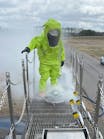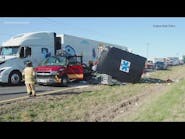Pre-incident planning allows emergency responders to anticipate the resources and procedures needed to meet specific demands within their jurisdictions.
The two primary customers served by fire prevention bureaus are the citizens we protect and fire department operations. There are many ways fire prevention can support fire department operations. One service that is often overlooked is the support or development of pre-incident plans.
Pre-incident planning allows emergency responders to anticipate the resources and procedures needed to meet specific demands within their jurisdictions. The complexity of today's fire protection systems, combined with changing building construction techniques, makes pre-incident planning imperative. There is just too much information for fire suppression personnel to remember about the structures in their response areas.
Pre-incident planning is the entire process of gathering and evaluating information, developing procedures based on that information, and ensuring that the information remains current. To obtain this information, company officers and unit personnel conduct pre-incident surveys of commercial, industrial, institutional occupancies, and high-risk (target) hazards within their response areas. The process of walking through the structures to gather data not only serves as a means to collect the information but also provides the opportunity for the company officer to discuss occupancy-specific tactics and become familiar with the building layout without smoke and fire conditions present. In many situations it is difficult to gather information during the pre-incident survey. Fire prevention bureau personnel can provide assistance during this function as well as during other pre-incident planning functions.
Pre-incident planning actually consists of the following four separate functions:
- Developing positive relationships with building owners/occupants - Most fire prevention bureaus have made contact with the building owner and property managers. They have some good insight of who to contact for a company walk through.
- Conducting the pre-incident survey - Fire prevention bureau personnel have an understanding of the complex fire protection systems installed in the building as well as an understanding of any hazardous materials storage issues.
- Managing pre-incident data - Depending on the size and structure of the fire prevention bureau, this may be the logical location to keep the pre-incident plan. This could be updated during annual fire inspections or during building modifications.
- Developing pre-incident plans - There is more to the development of pre-incident plans than just putting together a drawing. The process of developing the pre-incident plan is one the benefits of having a pre-plan. They need to be developed by the user (operations) and used by the developer (operations). This is an area where fire prevention should be assisting and supporting operations by sharing their fire prevention knowledge and experience.
Most of the information gathered during a pre-incident survey requires an understanding of basic fire prevention principles. During a survey, personnel should concentrate on the following factors:
- Where and how fires or other emergencies are most likely to occur?
- How those emergencies are likely to develop?
- What will likely happen as a result of a fire or emergency?
- What will be needed in order to mitigate contingencies?
- How building features such as fire walls and ventilation systems can be used to confine a fire to one section of the building?
- What will be the likely result of built-in fire protection systems such as automatic sprinklers?
- What potential hazards to firefighter safety exist on the premises:
- Hazardous materials or processes?
- High-voltage equipment?
- Unprotected openings?
- Metal-clad doors?
- Overhead power lines?
- Extreme elevation differences?
- Will the available emergency services organization be adequately prepared to safely and successfully deal with the emergencies that are most likely to occur in this occupancy?
- Will current strategic plans and tactical procedures be appropriate and adequate or will new ones need to be developed?
- How a situation will change if the occupant load is significantly different?
- Which size of initial alarm assignment will provide sufficient resources?
- Will specialized equipment or suppression agents be needed?
- What additional external resources or mutual aid will be required?
Basic to the pre-incident planning process though, is an understanding of the difference between a pre-incident survey and a fire and life safety code enforcement inspection. Pre-incident surveys are similar to fire and life safety inspections, although surveys are not intended to locate code violations. Periodically however, violations are discovered and depending on the severity of the fire code violation, the company officer may request the owner/occupant to correct the violation or simply report the problem to the authority's inspection division for follow up.
The company officer should also explain that while the facility survey is not a code enforcement inspection, any serious fire or life safety hazards found will need to be corrected. When serious hazards are found, the best approach is to obtain an on-the-spot correction and follow up with a written communication to the fire prevention/inspection division. If compliance cannot be immediately obtained, a fire inspector should be notified. This is one of the returned benefits to the fire prevention division.
Fire departments are currently faced with having fewer people and more tasks. Critical tasks such as pre-incident planning often get a lower priority because of staffing and time. Partnering with fire prevention in the pre-incident planning process is a great use of available resources to accomplish your fire department's mission. Remember too, that this is not only beneficial for operational needs as we have discussed but is a critical component of overall scene safety management.
BRETT LACEY, a Firehouse.com Contributing Editor, is the Fire Marshal for the Colorado Springs, CO, Fire Department and a professional engineer. He has over 27 years in the fire service and has served on various technical committees including NFPA 1031, IFSTA committee for Inspection practices, and Fire Detection and Suppression Systems and the Colorado Fire Marshal's Association Code Committee. PAUL VALENTINE, a Firehouse.com Contributing Editor, is the Fire Marshal for the Mount Prospect, IL, Fire Department and formerly served as their fire protection engineer. He has a Bachelor of Science Degree in Fire Protection and Safety Engineering Technology from Oklahoma State University and a Master of Science Degree in Management and Organizational Behavior from Benedictine University and is a graduate from the National Fire Academy's Executive Fire Officer Program. Brett and Paul co-authored Fire Prevention Applications, published by Fire Protection Publications. To read their complete biographies and view their archived articles, click here. You can reach Paul by e-mail at: [email protected].





